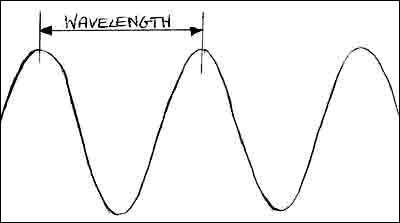Scientifics
Why Is the Sky Blue?
Maya Winters
I suppose a good place to start would be how we, as humans, are able to see. Now, I won't go into any technical details here. I’ll stick with a very simple answer: we see because our eyes receive light waves from the environment around us, and these light waves are processed into images. The most important points here are that ‘light’ is, in fact, just a form of energy and that it travels in waves.
What do we mean by a wave?
A wave is an oscillating signal which may have a sinusoidal shape, like the wave below. The wavelength of a wave is the distance between two peaks (the top of the waves), and can be considered as constant for the entire wave. The wavelength determines the amount of energy carried by a wave. Consequently, a longer wavelength means the wave has lower energy.

Visible Light
Light has a wide range of wavelengths that make up the electromagnetic spectrum. This spectrum includes a variety of types of light, ranging from short wavelengths (e.g. gamma rays, x-rays) to longer wavelengths (e.g. infra-red). Somewhere between these extremes is a range that we call ‘visible light’, so named because that’s the range of wavelengths the human eye is able to see.
You might think that the sun emits white light, but this is not the case! Within visible light, there is, in fact, a whole range of colours, from red, orange, and yellow (the longer wavelengths) to green, blue, purple, and violet (the shorter wavelengths). If you want proof of the colours of visible light, just think about a rainbow! When you see a rainbow, you are seeing the entire spectrum of light. White light is simply the combination of all of these various wavelengths of light traveling together.

What is air made of?
Having an idea about the composition of the atmosphere is important, because if you think about it, the sky is just that - air. Now, this air is simply a mix of different gases, mostly nitrogen (78%) and oxygen (21%), as well as argon gas and water (vapour, droplets, or ice crystals). Pollutants and particles like dust are also found in varying concentrations, but their exact composition varies from one place to another.
How do light waves interact with particles in the air?
This, in fact, is the fundamental question related to why the sky is blue. You see, light waves travel in straight lines until they are obstructed by something. In the atmosphere, this obstruction is normally a particle of some sort. All sorts of things affect the specifics of the interaction, but the most important are the wavelength of the light (remember that this is related to the energy of the wave) and the size of the particle it collides with.
Case 1: Collision with solid or liquid particles (relatively large)
In this case, the light wave is simply reflected in a different direction. The reflected light still appears as white light.
Case 2: Collision with gas particles (relatively small)
This second case is very different, because when light bumps into a gas particle, some of it can be absorbed by the particle. When the molecule, or particle, eventually releases the light, it is released in a different direction. The colour of the light will be the same as the colour that was absorbed from the original wave.
Gas molecules can absorb any wavelength of light, but the shorter wavelengths (blue light) are absorbed more. The light emitted from the molecules is scattered in all directions, as opposed to the other light, which simply follows one path. As blue light is absorbed, and thus scattered more than other wavelengths of light, the sky appears to be blue.
A few other points of interest:
- This scattering effect is known as ‘Rayleigh scattering’.
- The water droplets in clouds make the clouds appear white because they are so much larger than the molecules and particles in the air. This is an example of ‘Case 1’ scattering.
- The sky appears reddish-orange at sunsets due to the relative angle of the sun with the Earth’s surface. The blue and other shorter wavelengths are scattered far away from the horizon due to this angle, leaving the longer wavelengths, the red and orange, to reach our eyes.
- The sun emits a fairly high amount of ‘yellow wavelength’ light, which is why we normally draw it that colour. It seems to be most yellow when it is shining from directly above us. This is, again, due to the effect that the angle of light has on Rayleigh scattering.
-

On a side note, knowing the above also explains why the sky is black at night. It is the light from the sun that causes the blue colour of the sky, and so at night, when the sun is not visible, there is an absence of light, which appears as the colour black. The stars in the sky are too far away to provide enough light for this scattering effect like the sun does.
The sky being blue also proves how truly imperfect our world is. Obviously, if things were made perfectly, it would be the pink-purple wavelengths of the spectrum that would be scattered most!
Sources:
http://www.sciencemadesimple.com/sky_blue.html
http://www.math.ucr.edu/home/baez/physics/General/BlueSky/blue_sky.html
http://science.howstuffworks.com/question39.htm